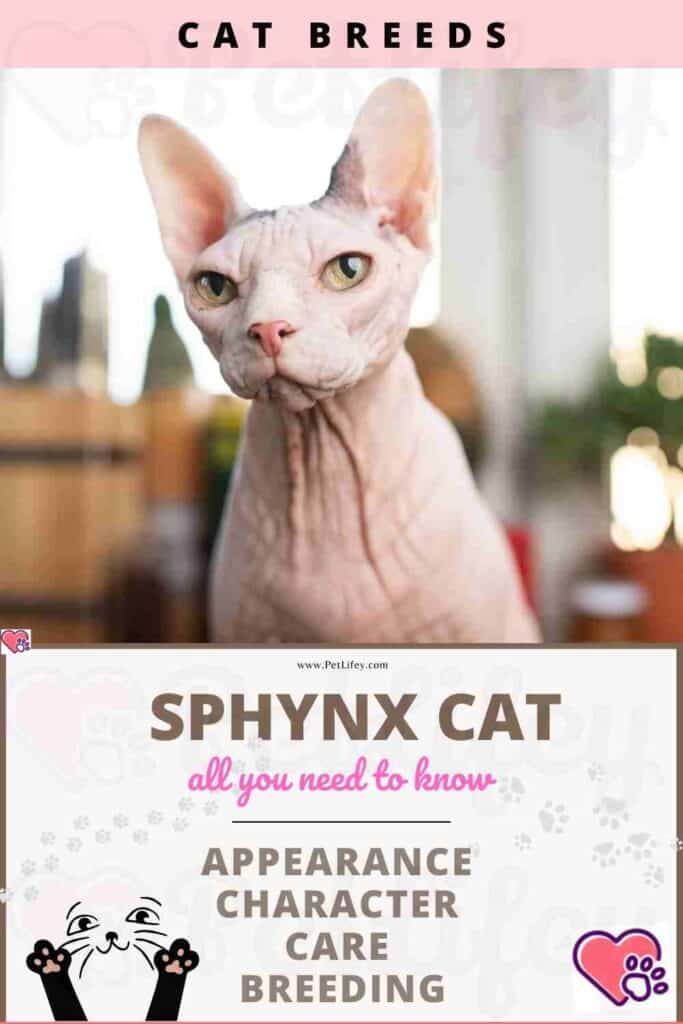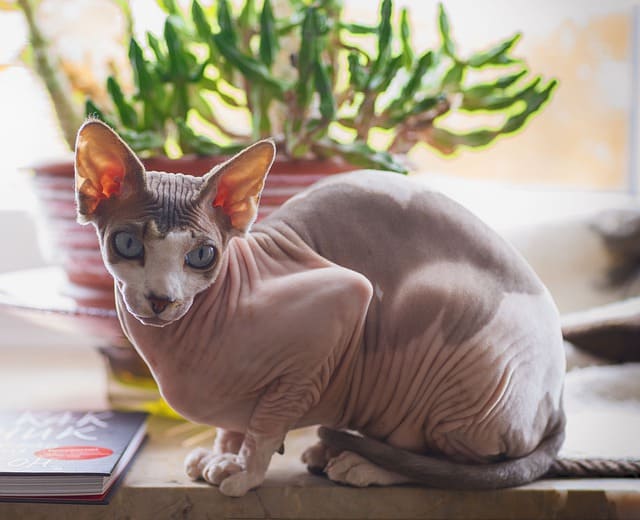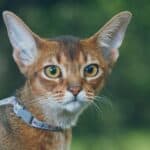
The Sphynx cat is a hairless cat that fascinates and upsets all who see it, in every sense of the word because the reaction can be both attraction and repulsion.
Repulsion because it doesn’t have a single hair, its veins can be seen pulsing under its wrinkled skin, not to mention that it has a rat tail and a head almost resembling that of a reptile, with bat ears.
It sounds more like the description of an alien than that of a cat, but if you don’t stop at the first impression, you can be completely mesmerized by its uniqueness, its elegance, its touching gaze and its skin. incredibly soft and warm.
The origins of the Sphynx Cat

Pre-Columbian engravings have been found showing hairless cats; others were described in 1830 in the Natural History of Paraguayan Mammals by JR Rengger, while at the beginning of the 20th century, some newspaper articles reported that Mexican hairless cats were on the verge of extinction.
From 1936, the birth of hairless cats was recorded in the United States as well as in France a few years later, but it was not until 1966, still in North America, that we tried to breed them, with very little success .
The Dutchman Hugo Hernandez collected some individuals carrying the American gene, worked at length on this gene and presented its cats in 1973; but it was not until ten years later that, in a Parisian exhibition, the Sphynx cat aroused great interest.
It should be remembered that this cat is the result of a natural genetic mutation, which the breeders confined themselves to fixing, without resorting to any manipulation.
Appearance of the Sphynx Cat
Cat of medium size, its head is also medium and angular, a little longer than wide, with very pronounced cheekbones; the nose is long and has no whiskers; the forehead is flat and the skull rounded.
Its ears are very large, broad at the base and very wide apart; the eyes , also set wide apart, have the shape of a lemon and are slightly tilted; their color matches that of their dress, even if in this case talking about skin is more appropriate.
The body has a fine bone structure and a compact and powerful musculature; the chest and shoulders are strong and well developed, the belly is always round and full.
The legs are in proportion to the body; the anterior ones are more apart because of the ample thorax; the feet are oval with very long toes; the pads are very thick.
The tail is also bare, like that of a rat, even if we admit a small tuft of hair at the end; it is long and thin, like a whip, very mobile and soft. The Sphynx cat obviously does not have a real coat, but it is covered with a light down.
The most obvious features are wrinkles and creases; wrinkles are located on the forehead, muzzle, chin, neck and legs, giving the impression of socks falling; young individuals have wrinkled whole bodies.
In adults, the wrinkles in the body then become folds that follow all the movements of the animal.
Coat color of the Sphynx Cat
Even if its colors are those of any cat, the absence of fur changes the shades more or less noticeably. To better illustrate this concept, let’s say for example that a white cat will not be this color but rather pink, and all the colourpoints will be very clear. Usually, the color of her coat will be the same as the color of her nose.
The character of the Sphynx Cat
The loyalty of the Sphynx cat is already legendary and it is, moreover, very sweet . Unlike most cats, it rarely goes on its master’s lap. The sphynx much prefers its shoulders! This is also one of its peculiarities, helping to easily take pictures.
It is a cat which combines intelligence with courage and which does not lack joyful mischief.
Hug:
Its eternal search for warmth means that this feline particularly appreciates caresses, especially if very warm hands give it to them! You will often find them under the covers, coiled against you.
Player:
It needs daily play sessions. They are active cats that require a lot of stimulation, whether through independent activities or interactive games with their owners.
Calm:
It’s a playful cat, but it also has its quiet moments when it likes to rest in a warm and cozy place that is intended for them (or that it will have appropriated on its own to your amazement).
Intelligent:
Its liveliness and curiosity make them an intelligent cat that will never cease to amaze you!
Fearful / Suspicious of Strangers:
The hairless Canadian cat tends to greet guests at the door. It can keep a small reserve at first, but its great curiosity quickly takes over. It quickly becomes the main attraction of all parties!
Independent:
This feline is quite capable of fending for itself, but it much prefers the presence of family members that it likes to snuggle up to to keep warm.
Behavior of the Sphynx Cat
Talkative:
The Sphynx can be heard, but is not known to be a very talkative cat.
Greedy / gluttonous:
The hairless Canadian cat is a good eater without being gluttonous. It expends a good amount of energy due to its moderately high activity level and thermoregulation. Its calorie intake must therefore be calculated accordingly.
Need for exercise:
A very energetic cat who loves to play. Some of them will even bring back their toys! It is a perfect cat for an active family.
Runaway:
Being clingy by nature due to its constant search for warmth, this hairless cat tends not to wander away and greatly prefers the comfort of its home.
Compatibility of the Sphynx Cat with other animals
The Sphynx and the Dogs:
This little feline enjoys the company of a dog. Besides, you will undoubtedly find it snuggled up against it to take advantage of the heat it gives off!
The Sphynx and Other Cats:
This cat knows how to adapt to the presence of other cats, especially individuals of its breed. If you are the proud owner of more than one Sphynx, you are likely to see stacks of melee cats.
The Sphynx and Children:
Being a lively and playful cat, it will enjoy the company of children who will keep them occupied and stimulated.
The Sphynx and the Elderly:
Although it can be calm and clingy, this tomcat has a moderately high energy level. It is important to ensure that there is no shortage of independent activities, but also interactive play sessions with its owners .
Caring for the Sphynx Cat
The sphynx, like most cats, loves heat. As its internal temperature is absolutely normal, it has a huge appetite: in fact, it needs a lot of food in order to be able to produce and accumulate the calories it needs.
Let us also remember that its skin is less well protected than that of a human being, because it does not have melanin; in fact, the only serious risk that the Sphynx cat runs is to burn itself in the sun, sometimes very seriously; so it needs a full screen protection cream when sunbathing, which it loves.
Grooming:
The skin of the hairless Canadian cat produces a lot of sebum, and without hair to absorb it, this sebum can sometimes clog its skin pores. A bath is recommended 1 to 2 times a year maximum.
Between baths, using a damp washcloth to remove excess sebum is ideal. Thorough cleaning of the ears on a weekly basis is also recommended since earwax production by them is abundant.
It is also necessary to pay particular attention to the interdigitated spaces and between the pads under the legs, the sebum tending to accumulate there. The skin of the hairless Canadian cat is also sensitive to sunburn.
We must take care of him apply sunscreen before prolonged exposure to UV rays.
Hair loss: The Sphynx does not lose hair. The light down on its skin and the slightly hairy areas of the head, ears, paws, scrotum and tail make up its unique ‘fur’.
Health of the Sphynx Cat
Resistant / robust:
Due to its lack of coat, this hairless cat is sensitive to cold temperatures and will try to find heat where it can (a heating unit, an electronic device, a hot stove, a sunny window sill, etc.), which can sometimes be problematic because of the risk of burns on devices that are too hot, but also sunburn.
Tendency to gain weight:
Since it tends to eat more due to the need to maintain its body temperature, special attention should be paid to the quality and quantity of food served.
The Sphynx is subject to one disease in particular: CMH . It is an inherited disease which can skip several generations. There is therefore no guarantee that a kitten will not be a carrier of the disease.
To sum up, CMH is a disease that causes the walls of the heart to shrink, making it breathe out faster. There are treatments to stabilize these effects, but they are expensive and often lifelong.
This disease also affects men. The heart of the Sphynx being close to that of man, research is being done on these cats, with the aim in particular of treating men.
To prevent this type of disease, it is therefore better to go for ultrasound scans at the vet, who will confirm or not if the Sphynx is subject to it.
Reproduction:
Special attention should be paid to the blood groups of breeding animals to avoid hemolytic anemia (neonatal isoerythrolysis) which is often fatal in kittens.
Food of the Sphynx Cat
It must eat a little more than other cats, because it expends more calories, to thermo regulate, than other breeds since it has no hair.
Good to know
The Sphynx, like humans and unlike other cats, sweat through the skin. It also sometimes has the particularity of leaving spots on the sleeping area because of the sebum on its skin.






